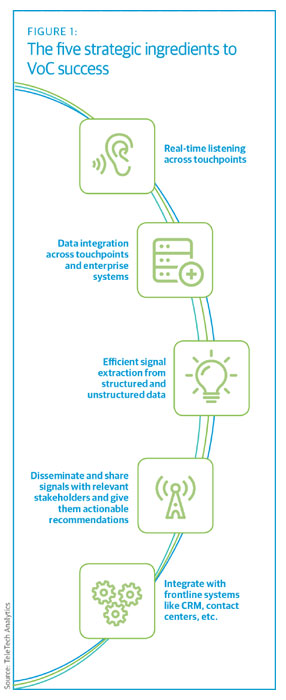Most customer experience leaders say they have active voice of the customer (VOC) programs in place. They track NPS, ask customers to complete post-interaction surveys, and employ speech analytics. But too often they are not really listening.
This was originally posted as an article in the Customer Strategist Journal.
To read the latest issue click here.
Research from Forrester found that 71 percent of respondents said their VOC program was not fully or mostly effective in driving actions. And Temkin Group says that although 70 percent of companies are collecting customer feedback, only one-third actually believe that they are designing problems to solutions or making changes to the business based on the insights. The Temkin Group reports that only 11 percent of companies have reached the top stages of VOC maturity (collaborators and transformers).
A voice of the customer strategy is an essential part of a strong CX analytics platform, but is often misunderstood and therefore poorly implemented. Why is success so elusive? There are four VOC myths that have taken hold over the years, repressing its potential. These myths need to first be dispelled if voice of the customer best practices are to be implemented.
MYTH 1: Voice of customer best practices equals lots of survey data
In the early days, the only voice of customer data that could be easily collected and analysed was survey data, and it soon became the norm. However, recently new sources of data have emerged and it has become easier to capture customer insights from them. The scope of VOC data has expanded to more than just self-stated survey responses. Other kinds of VOC data such as speech recordings from call centre transactions, emails, chat data, and social media comments, for example, provide more layers of information that can help companies better understand their customers’ actions. Any behaviour or perception that can be captured and analysed has the potential to provide even greater insights about customer motivations, frustrations, expectations, and experience. Adding a component of understanding helps answer “why” customers act the way they do.
MYTH 2: Voice of customer strategy only applies to our customer relationships
VOC should be renamed to voice of the consumer. Voices of potential prospects are highly relevant and insightful, too, and one could argue that in a growth company eager to identify new opportunities, the voice of the prospect is even more important than the customer’s. The prospect’s voice helps us identify opportunities for education, gives us insight into why we may not be in the consideration set for some, provides an awareness into a competitive strategy, and a lot more.
MYTH 3: Voice of customer is explicit customer feedback
It is a common misperception that the voice is always customer/prospect-initiated and explicit in the sense that they have to call-in, text, email us, or fill out a survey. While proactive customer outreach is certainly part of it, there’s much more. When your customers and prospects visit your website, for example, their clickstream data is VOC data that provides very valuable insights. When customers click on a banner ad or traverse aisles in a retail store, their behaviour qualifies as VOC data, as well.
MYTH 4: Voice of customer data on its own can improve customer experience (CX) and business performance
VOC data is extremely powerful and can provide invaluable insights on its own. However, it typically lacks information around a customer profile and transactional behaviour that reside in enterprise data warehouses and CRM systems. The real power of voice of the customer data comes when you can link all of these data sources. Linking data is critical to evaluate the worth of what can be learned from VOC data to make meaningful, actionable recommendations.
For example, you may receive 200 inbound calls a day to your call centre, and speech analytics tells you that on average most of the callers have a very negative sentiment because they are upset about the new pricing strategy recently launched. That is great information, but would you go out and change your pricing strategy based on that information alone? What if 90 percent of these calls came from low-value customers who represent only 5 percent of your revenue? Linking VOC to customer profile data and transactional behaviour is of paramount importance when deciding your best course of action.

Five voice of the customer best practices for business success
Robust VOC insight isn’t found in a software algorithm or dashboard report. Technical solutions available in the market are only one tool to create actionable VOC insight. Here are the five most important voice of the customer best practices to achieve VOC success and improve CX. Ideally, to achieve a holistic voice of the customer strategy, each of these best practices will align to the others across the entire organisation, not in just one department or business entity.
- Real-time listening across touchpoints
- Data integration across touchpoints and enterprise systems
- Efficient signal extraction from structured and unstructured data
- Disseminate and share signals with relevant stakeholders and give them actionable recommendations
- Integrate with frontline systems like CRM, contact centres, etc.
A centralised CX function or a cross-functional team that is championed by the CEO is usually the best place to start to develop and take action on a VOC strategy. One of the key things for this function to keep in mind is that they are not only leveraging the data and the insights developed in various siloed business units, but they are also leveraging the front-line capabilities of these business units to act on VOC strategy. Hence, collaboration is critical. Be careful not to replicate what already exists in the siloed business units. Start small with pilots to prove the value, and to foster collaboration with business units. When they see the value, then it is time to scale up and go into production.
A successful voice of customer strategy needs to evaluate the entire customer journey on all channels
Digital and mobile sources of customer data (websites, social media, smartphones) have not only become important sources of voice of the customer, but also critical channels for enabling the actions and insights learned from voice of the customer analytics.
Let us consider mobile. First, mobile can be a data collection channel. One has to take care to not just put current online surveys on mobile, but instead design for mobile to get instantaneous feedback. This means keeping it short and sweet. Second, mobile is more than just a data collection channel. With the amount of time customers are spending on mobile, it is a great source of implicit VOC. What customers are doing on mobile will provide insight into customer needs, preferences, and motivations (e.g., how often are they browsing on apps versus texting, etc.). What is the content that they are viewing and how engaged are they with it? Finally, mobile can also be used as a channel for action either via SMS, email, alerts, or other outreach.
Today, tracking visits on your own site (mobile or otherwise) can easily be done using cookies, resulting in what is typically known as first-party data. Third-party tracking is feasible as well with customer consent. Customers are very willing to share information as long as they get something in return, and in this case the promise is for a seamless, frictionless customer experience.
As we add additional channels to our VOC programs like digital and mobile to serve as both voice of the customer input and enablers of actions, it will become imperative to build capabilities in the following areas:
- Integrate the information collected from these channels with information collected from traditional channels.
- Analyse disparate sources of information in real time and extract signals
- Translate those insights into actions and determine the best channel(s) to leverage.






